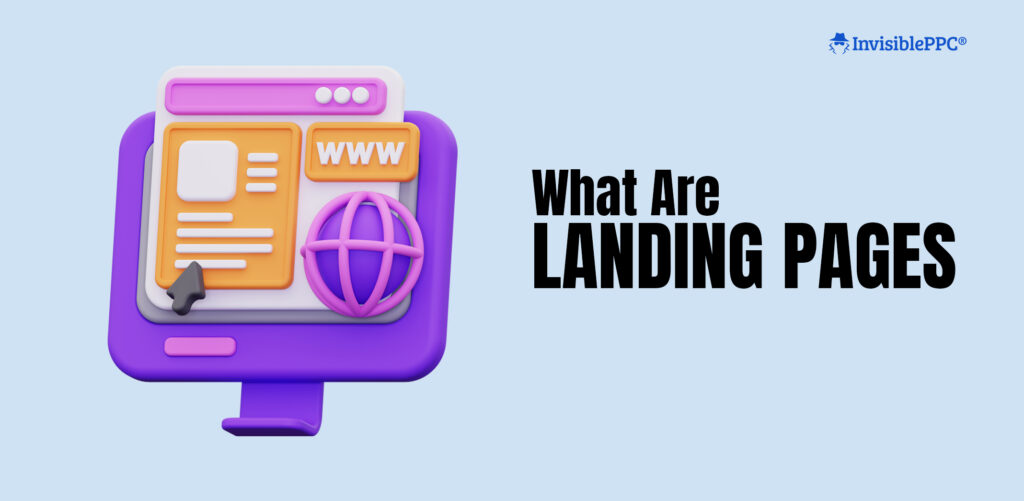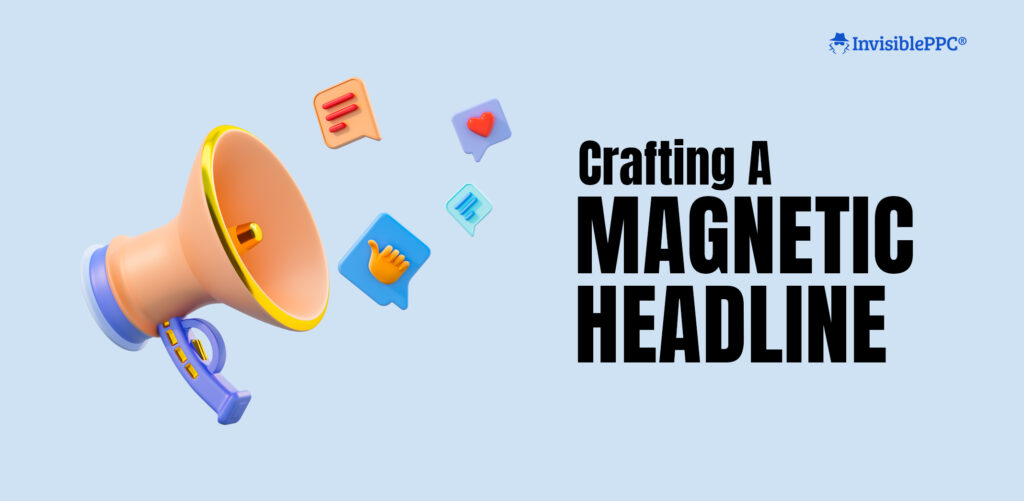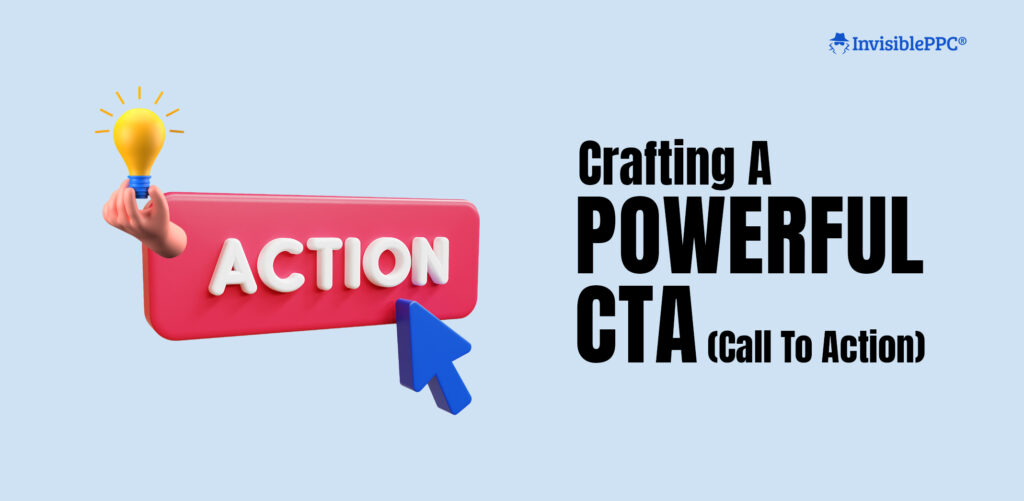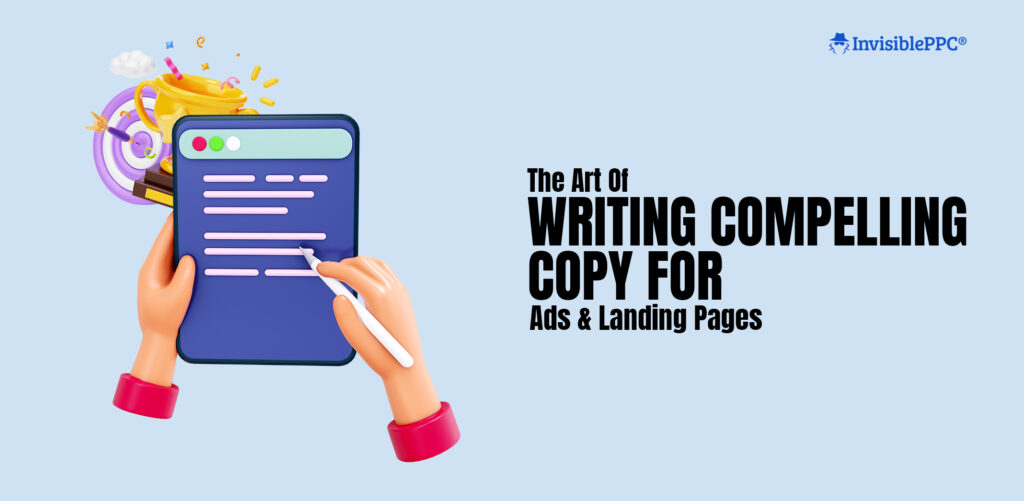Whether it’s an ad that pops up while someone scrolls through their feed or a landing page that a potential customer visits, the copy you write can make or break the connection.
And crafting compelling copes that strike the right chord with your audience is an art form. It demands a blend of creativity with strategy.
But how do you master this art?
That’s exactly what we will look at in this blog post.
This blog post is your masterclass in learning the art of writing compelling copies that not only grab attention but also convert.
Let’s start with the basics.
What are Landing Pages?

Landing pages are standalone web pages created specifically for marketing or advertising campaigns. They are the destination a visitor “lands” on after clicking on a link in an email, a Google or Facebook Ad, or a social media post.
Unlike the homepage, which serves multiple purposes and targets a broader audience, a landing page is designed with a single focus or goal, known as a call to action (CTA).
Let’s take a look at some of the key features of an effective landing pages:
1. One Goal: Each landing page is focused on one specific objective, whether it’s capturing leads, encouraging downloads, or driving purchases. This singular focus eliminates distractions and guides the visitor toward taking the desired action.
2. Targeted Messaging: The copy on a landing page is curated to align with the ad or link that brought the visitor there. This relevance increases the likelihood of conversions as it meets the visitor’s expectations and needs.
3. Clear and Compelling CTA: The call to action on a landing page is prominent, persuasive, and easy to follow. It tells visitors exactly what you want them to do next, like “Sign Up Now,” “Download Free eBook,” or “Get Started Today.”
4. Minimal Navigation: Unlike your main website, landing pages typically have minimal navigation options. This reduces the chances of visitors getting distracted or clicking away before completing the intended action.
5. Visual Appeal: Effective landing pages use visually appealing design elements that support the message and guide the visitor’s eye toward the CTA. This includes high-quality images, clean layouts, and strategically placed content.
6. Trust Elements: Including elements like testimonials, reviews, trust badges, or case studies can help build credibility and reassure visitors that they are making the right choice.
7. A/B Testing: Landing pages are often subject to A/B testing to determine which versions perform best. By changing elements like headlines, images, or CTA wording, marketers can optimize the page for higher conversion rates.
Now that you have an idea about the main features of a landing page, you can also refer to our Landing Page checklist to get a detailed blueprint of how to create an effective and foolproof landing page.
Understanding Your Audience
Before you even put pen to paper (or fingers to keyboard), you need to know who you’re talking to.
Understanding your audience is a crucial aspect of effective copywriting.
Who are they? What are their pain points? What motivates them?
Here are some points you can keep in mind to understand your audience:
1. Create Buyer Personas: These are detailed profiles of your ideal customers. Include demographics, interests, behaviors, and challenges.
2. Conduct Surveys and Interviews: Direct feedback from your audience is like hitting a jackpot. Use surveys, interviews, and social media interactions to gather insights.
3. Analyze Competitors: Look at what your competitors are doing well and where they’re falling short. This can reveal gaps in the market and opportunities for your copy to shine.
Crafting a Magnetic Headline

Your headline is the first impression, and you only get one chance to make it count. A great headline grabs attention, ignites curiosity, and encourages the reader to continue.
Here are some tips to craft a catchy headline:
1. Be Clear and Direct: Ambiguity kills interest. Make sure your headline clearly states what the reader can expect. For Example – Get *Flat 30% OFF* On Your New Roof Installation Today!
2. Use Power Words: Words like “FREE,” “NEW,” “FLAT x% OFF,” and “LIMITED OFFER” can trigger an emotional response.
3. Ask a Question: This engages the reader and makes them think about their own needs and desires.
4. Keep it Short: Aim for 6-12 words. Concise headlines are more impactful and easier to read. For example: Expert Plumbing Repairs – Get Fast & Affordable Plumbing!
Opening Strong with Your Lead
Once your headline has grabbed their attention, the opening paragraph needs to hook them in further. This is where you set the stage and convince the reader that what you’re offering is worth their time.
You can follow these tips to curate a strong opening paragraph:
1. Start with a Pain Point: Highlight a problem your audience faces and empathize with their struggle.
2. Tell a Story: Humans are wired to respond to stories. Share a relatable anecdote that ties into your message.
3. Make a Bold Statement: Something surprising or provocative can intrigue readers and encourage them to read on.
Writing Persuasive Body Copy
This is where you get into the details of what you’re offering and why it’s valuable. Your body copy needs to inform, persuade, and lead the reader toward taking action.
Here are some strategies you must keep in mind:
1. Focus on Benefits, Not Features: Instead of just listing what your product or service does, explain how it benefits the user.
2. Use Social Proof: Testimonials, case studies, and user reviews build trust. Show that others have benefited from your offering.
3. Break it Up: Use subheadings, bullet points, and short paragraphs to make your copy easy to skim. Most people won’t read every word, so make sure key points stand out.
4. Create a Sense of Urgency: Encourage immediate action with time-sensitive offers or limited availability.
Crafting a Powerful Call to Action (CTA)

Your CTA is where you seal the deal. It’s the final push that convinces your reader to take the desired action, whether that’s making a purchase, signing up for a newsletter, or downloading a resource.
Here’s how to make it compelling:
1. Be Clear and Specific: Avoid vague CTAs like “Click Here.” Instead, use action-oriented phrases like “Call Us Now” or “Start Your Free Trial.”
2. Highlight the Benefit: Remind the reader of the value they’ll get from taking action. For example, “Get Your Free Quote Now.”
3. Create Urgency: Words like “now” or “today” can encourage immediate action. For example, “Join Now and Save 20%.”
4. Make it Stand Out: Use contrasting colors, bold fonts, and strategic placement to ensure your CTA catches the eye.
Tailoring Your Copy for Different Platforms
Different platforms require different approaches. An ad on Facebook will have different constraints and opportunities compared to a landing page.
Here’s how you can approach different platforms:
1. Social Media Ads: Be brief and punchy. Use strong visuals and concise copy to capture attention quickly. Remember, people are scrolling fast.
2. Google Ads: Focus on keywords and relevance. Make sure your ad copy matches the search intent and includes a strong CTA.
3. Landing Pages: Here, you have more space to elaborate. Use a compelling headline, persuasive body copy, and a clear CTA. Make sure the page is visually appealing and easy to navigate.
Testing and Optimizing Your Copy
Even the best copy can be improved. Testing different versions of your copy can help you filter what works best for your target audience.
Let’s look at some ways to test your copy:
1. A/B Testing: Compare two versions of your ad or landing page to see which performs better. Change one element at a time (e.g., headline, CTA) to identify what makes the difference.
2. Analyze Metrics: Look at click-through rates, conversion rates, and bounce rates to gauge the effectiveness of your copy.
3. Iterate and Improve: Use the data from your tests to refine your copy. Continuous improvement is key to staying relevant and effective.
Writing compelling copy for ads and landing pages is no less than a strategic expedition of its own. It requires a deep understanding of your audience, a knack for storytelling, and a well-planned approach to persuasion.
A great copy doesn’t just happen; it’s crafted with care, tested, and refined over time. And we know while you will try your best to get it done, it might get overwhelming at some point.
We are here to make sure you have all the support you need and your business stands strong as InvisiblePPC takes over the task of crafting high-converting landing pages for you.
With our expertise and proven templates, you can focus on what you do best while we handle the rest!
So, let’s get started.

